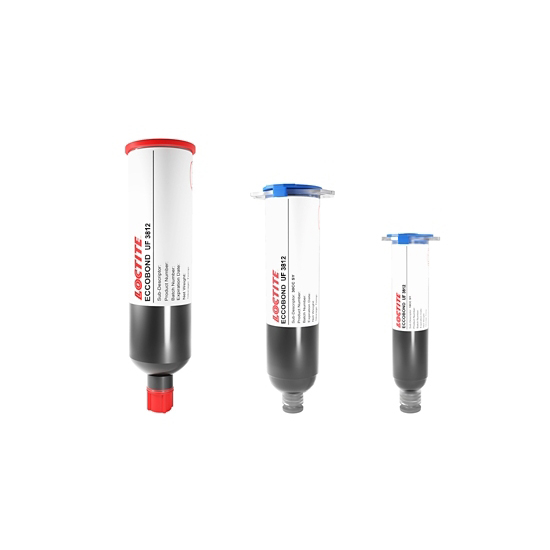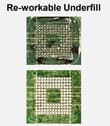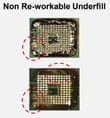LOCTITE ECCOBOND UF 3812
- Halogen free
- Room temperature flow
- One component
Product Description
LOCTITE ECCOBOND UF 3812 reworkable epoxy underfill is designed for CSP, WLCSP and BGA applications. This low viscosity material is formulated to flow at room temperature with no additional preheating required. It cures quickly at moderate temperatures to minimize stress to other components. This material's high glass transition temperature and high fracture toughness enables excellent protection of solder joints during thermal cycling.
LOCTITE ECCOBOND UF 3812 exhibits stable electrical performance under thermal/humidity bias is compatible with most Pb-free solder and has excellent thermal cycling performance.
Cure Schedule
- >10 minutes @ 130°C
Technical Specifications
| General Properties | |
| Pot Life Pot Life Pot life is the amount of time it takes for the viscosity of a material to double (or quadruple for lower viscosity materials) in room temperature after a material is mixed. It is closely related to work life but it is not application dependent, less precise and more of a general indication of how fast a system is going to cure. | 72 hours |
| Specific Gravity Specific Gravity Specific gravity (SG) is the ratio of the density of a substance to the density of a reference substance; equivalently, it is the ratio of the mass of a substance to the mass of a reference substance for the same given volume. For liquids, the reference substance is almost always water (1), while for gases, it is air (1.18) at room temperature. Specific gravity is unitless. | 1.23 |
| Work life @25°C Work life @25°C Work life is the amount of time we have to work with a material until it is no longer able to be easily worked and applied on a substrate. It is based on the change in viscosity and it can rely on the application requirements. | 24 hours |
| Thermal Properties | |
| Glass Transition Temperature (Tg) Glass Transition Temperature (Tg) The glass transition temperature for organic adhesives is a temperature region where the polymers change from glassy and brittle to soft and rubbery. Increasing the temperature further continues the softening process as the viscosity drops too. Temperatures between the glass transition temperature and below the decomposition point of the adhesive are the best region for bonding. The glass-transition temperature Tg of a material characterizes the range of temperatures over which this glass transition occurs. | 131 °C |
| Physical Properties | |
| Viscosity Viscosity Viscosity is a measurement of a fluid’s resistance to flow. Viscosity is commonly measured in centiPoise (cP). One cP is defined as the viscosity of water and all other viscosities are derived from this base. MPa is another common unit with a 1:1 conversion to cP. A product like honey would have a much higher viscosity -around 10,000 cPs- compared to water. As a result, honey would flow much slower out of a tipped glass than water would. The viscosity of a material can be decreased with an increase in temperature in order to better suit an application | 350 mPa.s |
Additional Information
What are the benefits of a reworkable underfill?
Working with a reworkable underfill post cure will demonstrate the following:
- The substrate has low residue after package de- bonding
- The underfill has low adhesion to the solder mask making mechanical scraping easy
- After cleaning, board surface is almost residue free
When we are using a non reworkable underfill on the other hand:
- Board surface shows >50% residue after package de-bonding. De-bonding also damages the substrate
- After cleaning, the board surface residue is 40% with 10% solder mask damage
It goes without saying that a reworkable underfill is highly preferred for applications that might require reworking at any point of their lifespan (for example repairing expensive motherboards or fine tuning already assembled parts)





